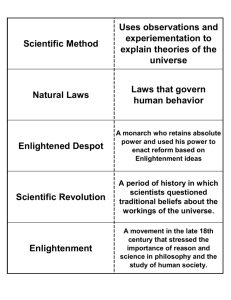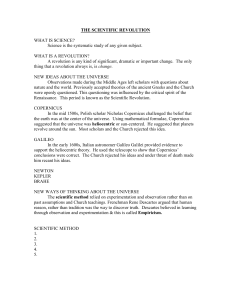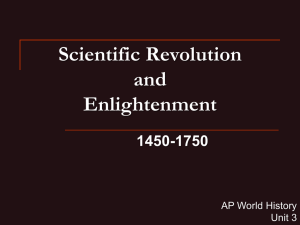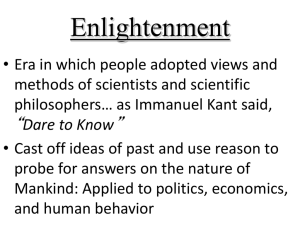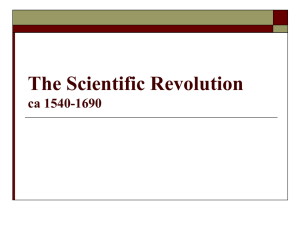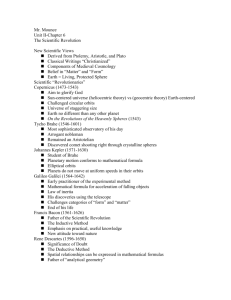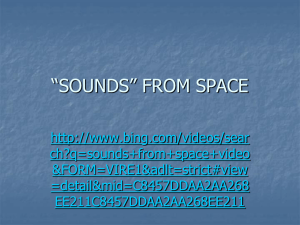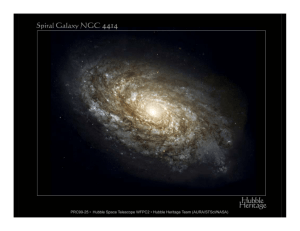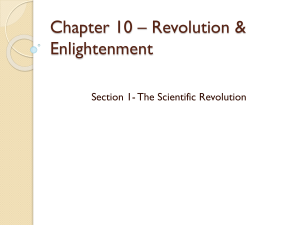HIS 31 Chapter 14 Power Point
advertisement
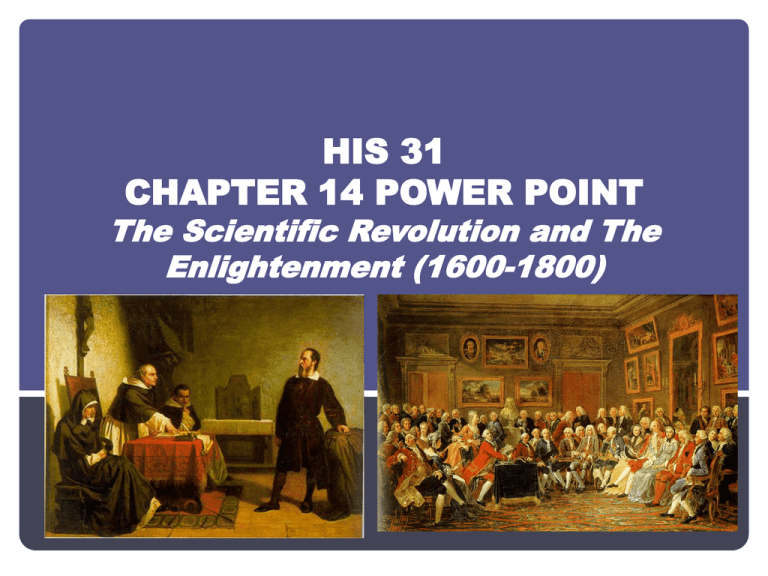
HIS 31 CHAPTER 14 POWER POINT The Scientific Revolution and The Enlightenment (1600-1800) KEY TERMS Neoplatonism – philosophy based on Plato’s ideas; one should search beyond appearances for true knowledge and the truth about nature and God could be found in abstract reasoning and be best expressed by mathematics Hermetic Doctrine – all matter contained the divine spirit which humans should seek to understand; sciences such as botany, chemistry, and metallurgy could unlock the secrets of nature Copernican Revolution – the change in belief from an earth-centered (geocentric) to a sun-centered (heliocentric) universe Heliocentric Model – theory that the sun is the center of the universe (and subsequently our solar system) Empirical Method – the use of observation and experiments based on sensory evidence to come to ideas or conclusions about nature Deductive Reasoning – deriving conclusions that logically flow from a premise (Rene Descartes’ theory) Cartesian Dualism – Descartes argued that there were two kinds of reality: mind (subjective thinking or experiencing) and body (objective physical matter) Scientific Revolution – 16th and 17th century methods of investigation and discoveries about nature based on observation and reason rather than tradition and authority Enlightenment – 18th century movement that stated human reason should determine understanding of the world and the rules of social life Philosophes – Enlightenment thinkers; French term for philosophers ANALYZING QUESTION 1 List and analyze the differences between the new scientific views of the world and traditional medieval views. How did standards for ascertaining the “truth” differ between these two perspectives? Scientific Views Traditional Views • Heliocentric theory • Truth about reason expressed through mathematics • Different scientific disciplines could unlock the secrets to the universe • Exploration and new navigational instruments further proved Ptolemy’s geographic map • Scientific Method • Earth and other heavenly bodies moved in circular orbits • Telescope revealed that heavenly bodies were imperfect structures • Planets move in ellipses • Physical relationship could be expressed mathematically • Law of gravity • Earth rested at the center of universe • Above the Earth were perfect spheres of air, fire, the sun, the planets, and the stars • God is the “prime mover” and he lies in the beyond • Angels are composed of pure matter • Earth was made of changeable, corrupt matter • Earth was the center of God’s concern • People lived by the wisdom of the ancient Greeks and Romans (Aristotle, Plato, Ptolemy) and authoritative interpretations of the Bible for centuries ANALYZING QUESTION 2 Analyze the beliefs and motives of three central figures in the Scientific Revolution. What barriers did they have to overcome to present their views? Galileo Galilei Isaac Newton Francis Bacon • He built and used his own telescope in 1609 to study the heavens • Formulated the principle of inertia (once bodies are set into motion will tend to stay in motion) • Discovered 4 moons orbiting Jupiter, the sun’s dark spots, and the moon’s surface was rough and uneven • In 1633, he was forced to confess to the Catholic Church that the ideas of Copernicus were false, otherwise he would have faced torture •Law of Gravitation = all physical objects are affected equally by the same force; this force ruled the motion of the planets and all matter on Earth and in space • Mathematically described three laws of motion: inertia, acceleration, and action/reaction • Developed calculus • Every object in the universe attracts every other object • He believed that God created the universe to function perfectly according to mathematics • Scientific conclusions could be reached through inductive reasoning – drawing general conclusions from particular concrete observations • Believed science would benefit commerce and industry and improve the human condition by giving people power over the environment • His development of the scientific method disregarded old scientists’ belief in longtrusted authorities • He believed experimentation and reasoning should based observed facts and math SCIENTIFIC METHOD ANALYZING QUESTION 4 In what ways did the Enlightenment threaten traditional views and authorities? *NOTE: All of the following views challenged the Catholic Church and the Divine Right of Kings (Absolute Monarchy) Voltaire - Fought for tolerance, reason, freedom of religious belief, and freedom of speech; denounced the religious doctrine of the Jesuits; was imprisoned twice for his views John Locke - Believed the purpose of government was to protect the natural rights of people (life, liberty, property) Montesquieu - He believed in separating the government into three branches: legislative, executive, and judicial; three branches of government would prevent tyrants from rising to power Rousseau – If a government violated people’s natural rights, it was the citizens’ responsibility to overthrow it; he believed that the only good government was one that was freely formed by the people and guided by the “general will” of society (direct democracy); his beliefs were expressed in The Social Contract (1762) Adam Smith – Wrote the Wealth of Nations (1776); he was a proponent of laissez-faire economics which argued that individuals who were allowed to rationally pursue their own economic self-interest would benefit society as well as themselves
